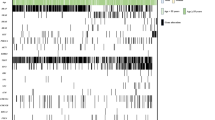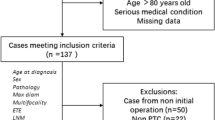Abstract
Introduction
Bilaterality is a newly identified indicator for aggressive tumor behavior and poor outcome in papillary thyroid cancer. However, the clonal origin of these bilateral tumors remains unclear.
Methods
Here we analyzed 28 pairs of early-stage papillary thyroid cancers (stage I–II without extra-thyroidal extension, lymph node metastasis or distant metastasis) that underwent surgery at First Affiliated Hospital of Zhejiang University School of Medicine (Hangzhou, China). Genomic DNA was extracted from paraffin-embedded tissues after microdissection and analyzed for BRAF mutation and X-chromosome inactivation.
Results
A total of 16 patients (16/28, 57.1%) harbored different BRAF status in bilateral tumors. Fourteen patients were available for X-chromosome inactivation assay and 10 of them achieved informative results. Bilateral tumors from four cases had distinct patterns of X-chromosome inactivation. Combining the results of X-chromosome inactivation and BRAF analysis, we demonstrated that at least 64.3% (18/28) cases harbored discordant X-chromosome inactivation or BRAF status, indicating their independent clonal origin in bilateral tumors.
Conclusions
The present study confirms “field cancerization” in early-stage bilateral thyroid cancers, suggesting that these subtype papillary thyroid cancers should be treated as independent and localized tumors.

Similar content being viewed by others
References
R.L. Siegel, K.D. Miller, A. Jemal, Cancer statistics, 2018. CA Cancer J. Clin. 68(1), 7–30 (2018). https://doi.org/10.3322/caac.21442
K.D. Miller, R.L. Siegel, C.C. Lin, A.B. Mariotto, J.L. Kramer, J.H. Rowland, K.D. Stein, R. Alteri, A. Jemal, Cancer treatment and survivorship statistics, 2016. CA Cancer J. Clin. 66(4), 271–289 (2016). https://doi.org/10.3322/caac.21349
M.R. Haymart, M. Banerjee, A.K. Stewart, R.J. Koenig, J.D. Birkmeyer, J.J. Griggs, Use of radioactive iodine for thyroid cancer. JAMA 306(7), 721–728 (2011). https://doi.org/10.1001/jama.2011.1139
S. Markovina, P.W. Grigsby, J.K. Schwarz, T. DeWees, J.F. Moley, B.A. Siegel, S.M. Perkins, Treatment approach, surveillance, and outcome of well-differentiated thyroid cancer in childhood and adolescence. Thyroid 24(7), 1121–1126 (2014). https://doi.org/10.1089/thy.2013.0297
S.C. Pitt, R.S. Sippel, H. Chen, Contralateral papillary thyroid cancer: does size matter? Am. J. Surg. 197(3), 342–347 (2009). https://doi.org/10.1016/j.amjsurg.2008.09.011
J.L. Pasieka, N.W. Thompson, M.K. McLeod, R.E. Burney, M. Macha, The incidence of bilateral well-differentiated thyroid cancer found at completion thyroidectomy. World J. Surg. 16(4), 711–716 (1992). discussion 716-717
B.S. Koo, H.S. Lim, Y.C. Lim, Y.H. Yoon, Y.M. Kim, Y.H. Park, K.S. Rha, Occult contralateral carcinoma in patients with unilateral papillary thyroid microcarcinoma. Ann. Surg. Oncol. 17(4), 1101–1105 (2010). https://doi.org/10.1245/s10434-009-0906-6
W. Wang, W. Zhao, H. Wang, X. Teng, H. Wang, X. Chen, Z. Li, X. Yu, T.J. Fahey 3rd, L. Teng, Poorer prognosis and higher prevalence of BRAF (V600E) mutation in synchronous bilateral papillary thyroid carcinoma. Ann. Surg. Oncol. 19(1), 31–36 (2012). https://doi.org/10.1245/s10434-011-2096-2
W. Wang, X. Su, K. He, Y. Wang, H. Wang, H. Wang, Y. Zhao, W. Zhao, R. Zarnegar, T.J. Fahey 3rd, X. Teng, L. Teng, Comparison of the clinicopathologic features and prognosis of bilateral versus unilateral multifocal papillary thyroid cancer: an updated study with more than 2000 consecutive patients. Cancer 122(2), 198–206 (2016). https://doi.org/10.1002/cncr.29689
M.F. Lyon, Sex chromatin and gene action in the mammalian X-chromosome. Am. J. Hum. Genet. 14, 135–148 (1962)
C. Swanton, Intratumor heterogeneity: evolution through space and time. Cancer Res. 72(19), 4875–4882 (2012). https://doi.org/10.1158/0008-5472.CAN-12-2217
M. Gerlinger, A.J. Rowan, S. Horswell, M. Math, J. Larkin, D. Endesfelder, E. Gronroos, P. Martinez, N. Matthews, A. Stewart, P. Tarpey, I. Varela, B. Phillimore, S. Begum, N.Q. McDonald, A. Butler, D. Jones, K. Raine, C. Latimer, C.R. Santos, M. Nohadani, A.C. Eklund, B. Spencer-Dene, G. Clark, L. Pickering, G. Stamp, M. Gore, Z. Szallasi, J. Downward, P.A. Futreal, C. Swanton, Intratumor heterogeneity and branched evolution revealed by multiregion sequencing. N. Engl. J. Med. 366(10), 883–892 (2012). https://doi.org/10.1056/NEJMoa1113205
E.C. de Bruin, N. McGranahan, R. Mitter, M. Salm, D.C. Wedge, L. Yates, M. Jamal-Hanjani, S. Shafi, N. Murugaesu, A.J. Rowan, E. Gronroos, M.A. Muhammad, S. Horswell, M. Gerlinger, I. Varela, D. Jones, J. Marshall, T. Voet, P. Van Loo, D.M. Rassl, R.C. Rintoul, S.M. Janes, S.M. Lee, M. Forster, T. Ahmad, D. Lawrence, M. Falzon, A. Capitanio, T.T. Harkins, C.C. Lee, W. Tom, E. Teefe, S.C. Chen, S. Begum, A. Rabinowitz, B. Phillimore, B. Spencer-Dene, G. Stamp, Z. Szallasi, N. Matthews, A. Stewart, P. Campbell, C. Swanton, Spatial and temporal diversity in genomic instability processes defines lung cancer evolution. Science 346(6206), 251–256 (2014). https://doi.org/10.1126/science.1253462
M. Xing, Molecular pathogenesis and mechanisms of thyroid cancer. Nat. Rev. Cancer 13(3), 184–199 (2013)
J.A. Knauf, X. Ma, E.P. Smith, L. Zhang, N. Mitsutake, X.H. Liao, S. Refetoff, Y.E. Nikiforov, J.A. Fagin, Targeted expression of BRAFV600E in thyroid cells of transgenic mice results in papillary thyroid cancers that undergo dedifferentiation. Cancer Res. 65(10), 4238–4245 (2005). https://doi.org/10.1158/0008-5472.CAN-05-0047
Z. Lu, J. Sheng, Y. Zhang, J. Deng, Y. Li, A. Lu, J. Zhang, H. Yu, M. Zhang, Z. Xiong, H. Yan, B.H. Diplas, Y. Lu, B. Liu, Clonality analysis of multifocal papillary thyroid carcinoma by using genetic profiles. J. Pathol. 239(1), 72–83 (2016). https://doi.org/10.1002/path.4696
T.M. Shattuck, W.H. Westra, P.W. Ladenson, A. Arnold, Independent clonal origins of distinct tumor foci in multifocal papillary thyroid carcinoma. N. Engl. J. Med. 352(23), 2406–2412 (2005). https://doi.org/10.1056/NEJMoa044190
S.Y. Park, Y.J. Park, Y.J. Lee, H.S. Lee, S.H. Choi, G. Choe, H.C. Jang, S.H. Park, D.J. Park, B.Y. Cho, Analysis of differential BRAF(V600E) mutational status in multifocal papillary thyroid carcinoma: evidence of independent clonal origin in distinct tumor foci. Cancer 107(8), 1831–1838 (2006). https://doi.org/10.1002/cncr.22218
W. Wang, H. Wang, X. Teng, H. Wang, C. Mao, R. Teng, W. Zhao, J. Cao, T.J. Fahey 3rd, L. Teng, Clonal analysis of bilateral, recurrent, and metastatic papillary thyroid carcinomas. Hum. Pathol. 41(9), 1299–1309 (2010). https://doi.org/10.1016/j.humpath.2010.02.008
R.P. McCarthy, M. Wang, T.D. Jones, R.W. Strate, L. Cheng, Molecular evidence for the same clonal origin of multifocal papillary thyroid carcinomas. Clin. Cancer Res. 12(8), 2414–2418 (2006). https://doi.org/10.1158/1078-0432.CCR-05-2818
T.J. O’Grady, M.A. Gates, F.P. Boscoe, Thyroid cancer incidence attributable to overdiagnosis in the United States 1981–2011. Int. J. Cancer 137(11), 2664–2673 (2015). https://doi.org/10.1002/ijc.29634
C.M. Kitahara, J.A. Sosa, The changing incidence of thyroid cancer. Nat. Rev. Endocrinol. 12(11), 646–653 (2016). https://doi.org/10.1038/nrendo.2016.110
L. Klotz, Cancer overdiagnosis and overtreatment. Curr. Opin. Urol. 22(3), 203–209 (2012). https://doi.org/10.1097/MOU.0b013e32835259aa
S. Jegerlehner, J.L. Bulliard, D. Aujesky, N. Rodondi, S. Germann, I. Konzelmann, A. Chiolero, N.W. Group, Overdiagnosis and overtreatment of thyroid cancer: a population-based temporal trend study. PLoS ONE 12(6), e0179387 (2017). https://doi.org/10.1371/journal.pone.0179387
R.P. Tufano, S.I. Noureldine, P. Angelos, Incidental thyroid nodules and thyroid cancer: considerations before determining management. JAMA Otolaryngol. Head Neck Surg. 141(6), 566–572 (2015). https://doi.org/10.1001/jamaoto.2015.0647
R.A. DeLellis, Pathology and genetics of thyroid carcinoma. J. Surg. Oncol. 94(8), 662–669 (2006). https://doi.org/10.1002/jso.20700
N.D. Perrier, J.D. Brierley, R.M. Tuttle, Differentiated and anaplastic thyroid carcinoma: major changes in the American Joint Committee on Cancer eighth edition cancer staging manual. CA Cancer J. Clin. 68(1), 55–63 (2018). https://doi.org/10.3322/caac.21439
R.C. Allen, H.Y. Zoghbi, A.B. Moseley, H.M. Rosenblatt, J.W. Belmont, Methylation of HpaII and HhaI sites near the polymorphic CAG repeat in the human androgen-receptor gene correlates with X chromosome inactivation. Am. J. Hum. Genet. 51(6), 1229–1239 (1992)
W.D. Tilley, M. Marcelli, J.D. Wilson, M.J. McPhaul, Characterization and expression of a cDNA encoding the human androgen receptor. Proc. Natl Acad. Sci. USA 86(1), 327–331 (1989)
S. Moniz, A.L. Catarino, A.R. Marques, B. Cavaco, L. Sobrinho, V. Leite, Clonal origin of non-medullary thyroid tumours assessed by non-random X-chromosome inactivation. Eur. J. Endocrinol. 146(1), 27–33 (2002)
H. Davies, G.R. Bignell, C. Cox, P. Stephens, S. Edkins, S. Clegg, J. Teague, H. Woffendin, M.J. Garnett, W. Bottomley, N. Davis, E. Dicks, R. Ewing, Y. Floyd, K. Gray, S. Hall, R. Hawes, J. Hughes, V. Kosmidou, A. Menzies, C. Mould, A. Parker, C. Stevens, S. Watt, S. Hooper, R. Wilson, H. Jayatilake, B.A. Gusterson, C. Cooper, J. Shipley, D. Hargrave, K. Pritchard-Jones, N. Maitland, G. Chenevix-Trench, G.J. Riggins, D.D. Bigner, G. Palmieri, A. Cossu, A. Flanagan, A. Nicholson, J.W. Ho, S.Y. Leung, S.T. Yuen, B.L. Weber, H.F. Seigler, T.L. Darrow, H. Paterson, R. Marais, C.J. Marshall, R. Wooster, M.R. Stratton, P.A. Futreal, Mutations of the BRAF gene in human cancer. Nature 417(6892), 949–954 (2002). https://doi.org/10.1038/nature00766
P.C. Nowell, The clonal evolution of tumor cell populations. Science 194(4260), 23–28 (1976)
D.P. Slaughter, H.W. Southwick, W. Smejkal, Field cancerization in oral stratified squamous epithelium; clinical implications of multicentric origin. Cancer 6(5), 963–968 (1953)
V.M. van Houten, C.R. Leemans, J.A. Kummer, J. Dijkstra, D.J. Kuik, M.W. van den Brekel, G.B. Snow, R.H. Brakenhoff, Molecular diagnosis of surgical margins and local recurrence in head and neck cancer patients: a prospective study. Clin. Cancer Res. 10(11), 3614–3620 (2004). https://doi.org/10.1158/1078-0432.CCR-03-0631
K. Shiga, T. Ogawa, F. Yoshida, K. Matsuura, M. Tateda, S. Saijo, T. Miyagi, T. Kobayashi, Multiple squamous cell carcinomas of the head and neck show different phenotypes of allelic loss patterns suggesting different clonal origin of carcinogenesis. Anticancer Res. 23(5A), 3911–3915 (2003)
G.H. Heppner, F.R. Miller, The cellular basis of tumor progression. Int. Rev. Cytol. 177, 1–56 (1998)
H. Chai, R.E. Brown, Field effect in cancer-an update. Ann. Clin. Lab. Sci. 39(4), 331–337 (2009)
W.C. Kisseberth, E.P. Sandgren, Polyclonal development of mouse mammary preneoplastic nodules. Cancer Res. 64(3), 857–863 (2004)
A.J. Merritt, K.A. Gould, W.F. Dove, Polyclonal structure of intestinal adenomas in ApcMin/+mice with concomitant loss of Apc+ from all tumor lineages. Proc. Natl Acad. Sci. USA 94(25), 13927–13931 (1997)
M.R. Novelli, J.A. Williamson, I.P. Tomlinson, G. Elia, S.V. Hodgson, I.C. Talbot, W.F. Bodmer, N.A. Wright, Polyclonal origin of colonic adenomas in an XO/XY patient with FAP. Science 272(5265), 1187–1190 (1996)
D.J. Winton, M.A. Blount, B.A. Ponder, Polyclonal origin of mouse skin papillomas. Br. J. Cancer 60(1), 59–63 (1989)
Acknowledgements
This study is supported by Grants from National Natural Science Foundation of China (No. 81202141, and 81272676), the Key Project of Scientific and Technological Innovation of Zhejiang Province (No. 2015C03G2010206), National Science and Technology Major Project of the Ministry of Science and Technology of China (No. 2013ZX09506015), Medical Science and Technology Project of Zhejiang Province (No. 2011ZDA009), and Natural Science Foundation of Zhejiang Province (No. Y2110414).
Author information
Authors and Affiliations
Corresponding authors
Ethics declarations
Conflict of interest
The authors declare that they have no conflict of interest.
Ethical approval and informed consent
This study was approved by the Institutional Review Board of First Affiliated Hospital, Zhejiang University School of Medicine. Informed consent has been obtained from each patient after full explanation of the purpose and nature of all procedures were used according to the Helsinki Declaration of 1975, as revised in 1983.
Additional information
Publisher’s note: Springer Nature remains neutral with regard to jurisdictional claims in published maps and institutional affiliations.
Rights and permissions
About this article
Cite this article
Su, X., Chen, S., He, K. et al. Clonal analysis of early-stage bilateral papillary thyroid cancer identifies field cancerization. Endocrine 64, 614–621 (2019). https://doi.org/10.1007/s12020-019-01877-1
Received:
Accepted:
Published:
Issue Date:
DOI: https://doi.org/10.1007/s12020-019-01877-1




